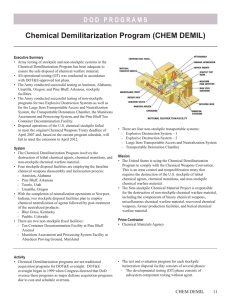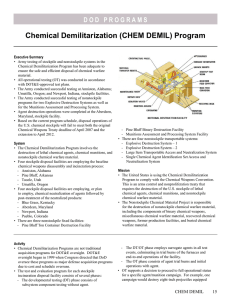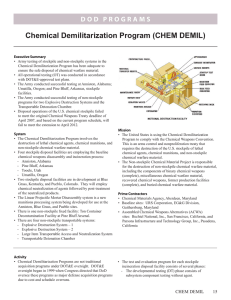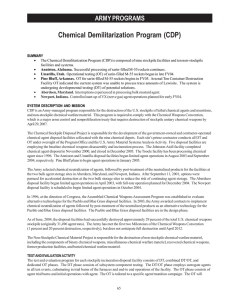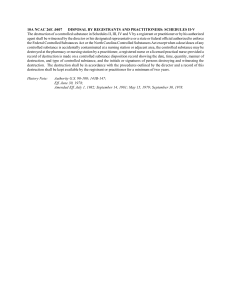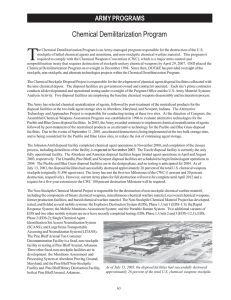Chemical Demilitarization Program – Assembled Chemical Weapons Alternatives (CHEM DEMIL-ACWA)
advertisement
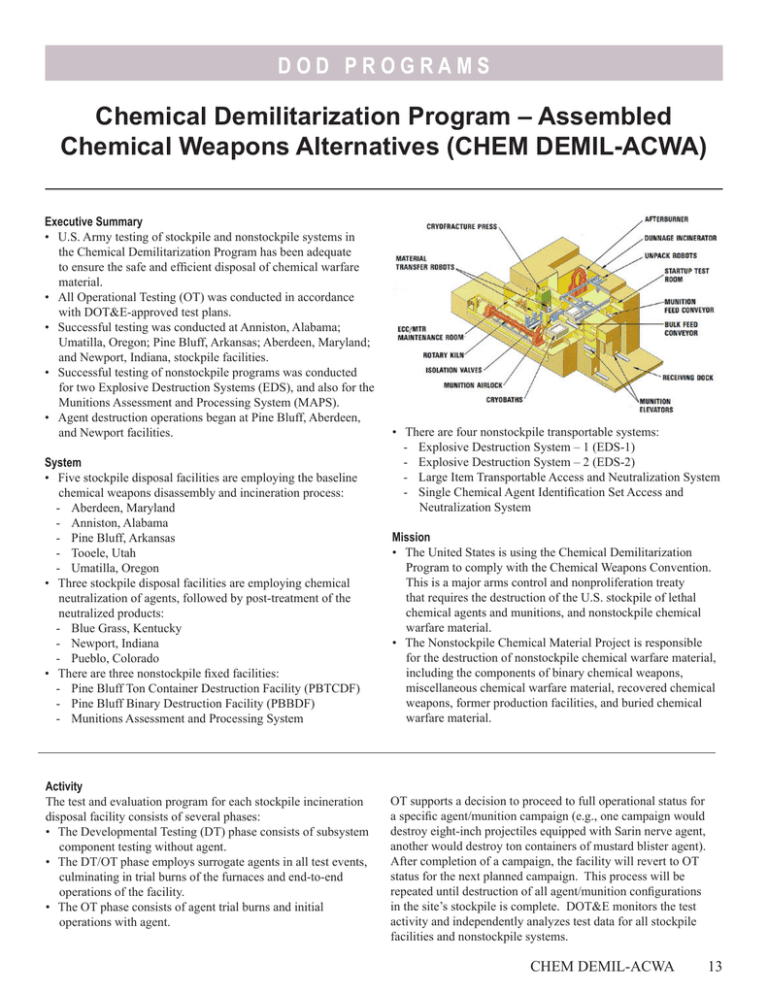
DOD PROGRAMS Chemical Demilitarization Program – Assembled Chemical Weapons Alternatives (CHEM DEMIL-ACWA) Executive Summary • U.S. Army testing of stockpile and nonstockpile systems in the Chemical Demilitarization Program has been adequate to ensure the safe and efficient disposal of chemical warfare material. • All Operational Testing (OT) was conducted in accordance with DOT&E-approved test plans. • Successful testing was conducted at Anniston, Alabama; Umatilla, Oregon; Pine Bluff, Arkansas; Aberdeen, Maryland; and Newport, Indiana, stockpile facilities. • Successful testing of nonstockpile programs was conducted for two Explosive Destruction Systems (EDS), and also for the Munitions Assessment and Processing System (MAPS). • Agent destruction operations began at Pine Bluff, Aberdeen, and Newport facilities. System • Five stockpile disposal facilities are employing the baseline chemical weapons disassembly and incineration process: - Aberdeen, Maryland - Anniston, Alabama - Pine Bluff, Arkansas - Tooele, Utah - Umatilla, Oregon • Three stockpile disposal facilities are employing chemical neutralization of agents, followed by post-treatment of the neutralized products: - Blue Grass, Kentucky - Newport, Indiana - Pueblo, Colorado • There are three nonstockpile fixed facilities: - Pine Bluff Ton Container Destruction Facility (PBTCDF) - Pine Bluff Binary Destruction Facility (PBBDF) - Munitions Assessment and Processing System Activity The test and evaluation program for each stockpile incineration disposal facility consists of several phases: • The Developmental Testing (DT) phase consists of subsystem component testing without agent. • The DT/OT phase employs surrogate agents in all test events, culminating in trial burns of the furnaces and end-to-end operations of the facility. • The OT phase consists of agent trial burns and initial operations with agent. • There are four nonstockpile transportable systems: - Explosive Destruction System – 1 (EDS-1) - Explosive Destruction System – 2 (EDS-2) - Large Item Transportable Access and Neutralization System - Single Chemical Agent Identification Set Access and Neutralization System Mission • The United States is using the Chemical Demilitarization Program to comply with the Chemical Weapons Convention. This is a major arms control and nonproliferation treaty that requires the destruction of the U.S. stockpile of lethal chemical agents and munitions, and nonstockpile chemical warfare material. • The Nonstockpile Chemical Material Project is responsible for the destruction of nonstockpile chemical warfare material, including the components of binary chemical weapons, miscellaneous chemical warfare material, recovered chemical weapons, former production facilities, and buried chemical warfare material. OT supports a decision to proceed to full operational status for a specific agent/munition campaign (e.g., one campaign would destroy eight-inch projectiles equipped with Sarin nerve agent, another would destroy ton containers of mustard blister agent). After completion of a campaign, the facility will revert to OT status for the next planned campaign. This process will be repeated until destruction of all agent/munition configurations in the site’s stockpile is complete. DOT&E monitors the test activity and independently analyzes test data for all stockpile facilities and nonstockpile systems. CHEM DEMIL-ACWA 13 DOD PROGRAMS Eight M55 rocket fires occurred during processing at baseline facilities, including six in FY05 at Umatilla Chemical Destruction Facility and Pine Bluff Chemical Destruction Facility. The root cause for these events is unknown, and an investigation is ongoing. Additionally, following processing of multipleround packages in the nonstockpile Explosive Destruction System-2, agent presence was detected. In both cases, all safety systems worked as designed, and the chemical agent never left engineering control. As of March 2005, approximately 36 percent of the total U.S. chemical weapons stockpile (originally 31,496 agent tons) had been destroyed. FY05 test activity for stockpile facilities and nonstockpile systems is summarized in the table below. the safe and efficient disposal of chemical warfare material. The U.S. Army Material Systems Analysis Activity is providing effective independent oversight of the testing of both stockpile and nonstockpile programs. Their expertise and vigilance have resulted in the early identification and resolution of the problems that surface from time-to-time. Fully integrated operational demos that confirm all phases of preparation, destruction/ neutralization, and disposal work as intended remain a critical criterion before transition to operations with live agent. Recommendations None. Assessment U.S. Army testing of stockpile and nonstockpile systems in the Chemical Demilitarization Program has been adequate to ensure Chem Demil Test and Evaluation Activity Facility/System Anniston Technology Incineration FY05 Activity OT Agent Tested Sarin (a) Planned FY06 Activity OT Umatilla Pine Bluff Aberdeen Newport EDS-1/2,3 EDS-2 MAPS PBBDF PBTCDF Incineration Incineration Neutralization Neutralization Neutralization Neutralization Neutralization Neutralization Neutralization OT DT/OT; OT DT; OT DT/OT; OT FOT&E (f) FOT&E (g) DT/OT DT OT Sarin (b) Surrogate, Sarin (c) Mustard (d) Surrogate, VX (e) Lewisite, Arsenicals, VX Mustard Surrogate, Mustard, Sarin, Phosgene Surrogate Potential trace agent (Lewisite observed) OT OT OT OT FOT&E FOT&E FOT&E (h) OT OT (a) Sarin-filled eight-inch, 155 mm, and 105 mm projectiles were tested. (b) Sarin-filled MC-1 bombs and ton containers were tested. (c) Sarin-filled M-55 rockets were tested. (d) Mustard agent destruction complete February 2005. Ton container cleanout process was tested. (e) VX-filled ton containers were tested. (f) An Operational In-Process Review conditional fielding decision for EDS-1/2,3 was made in October 2002. (g) An Operational In-Process Review conditional fielding decision for EDS-2 was made in September 2004. (h) FOT&E will commence upon availability of appropriate recovered chemical munitions. 14 CHEM DEMIL-ACWA
